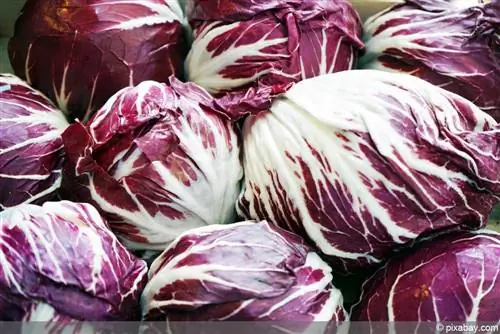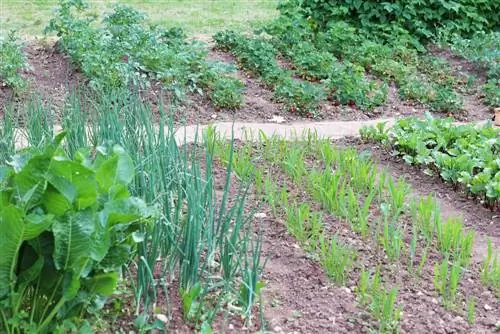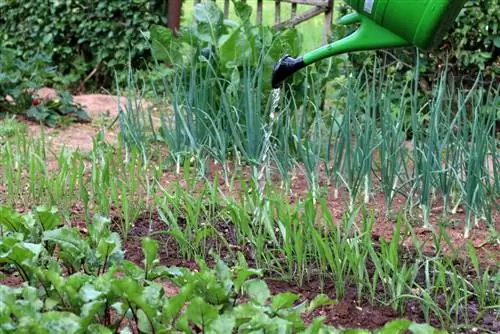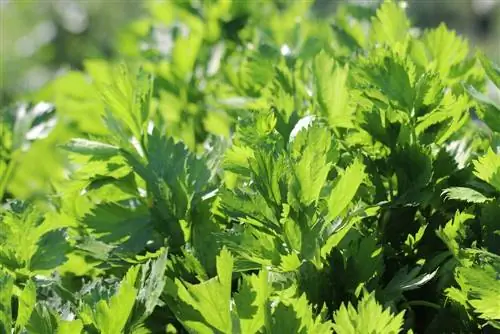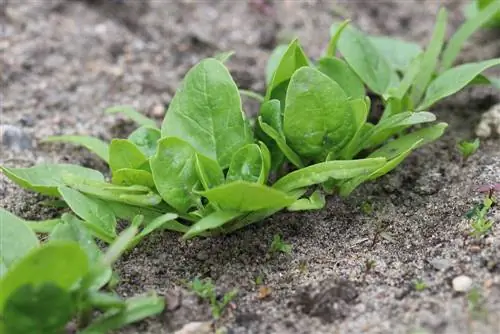- Author admin [email protected].
- Public 2023-12-17 03:39.
- Last modified 2025-01-24 12:45.
In addition to the various local types of lettuce, growing radicchio in your own garden is becoming increasingly popular. In addition to its red color, it also has a different, slightly bitter taste and has become a popular and decorative salad addition. Originally native to Italy, it would also like a mild climate in the local latitudes in order to thrive. But there are different varieties that are also well suited to northern climates. Growing and caring for radicchio in your own vegetable garden is therefore relatively easy.
Various varieties
Radicchio salad is a relatively new cultivated vegetable in local gardens that originally comes from the Mediterranean region. While the first lettuces in supermarkets were imported from Italy in the 1980s, hobby gardeners also became aware of them at that time. A distinction is made between different species, which also form further sub-varieties:
Rosso di Chioggia, also Radicchio Rosso or Palla Rossa
- white leaf veins
- red to dark red leaves
- round head, similar in shape to the cabbage
Variegato di Castelfranco
- light green or cream
- round heads
- red speckled
Rossa di Verona
- Shape similar to lettuce
- dark red color
- also rosette chicory
- or winter radicchio
Treviso
- Head shape is elongated
- red to dark red leaves
- white leaf veins
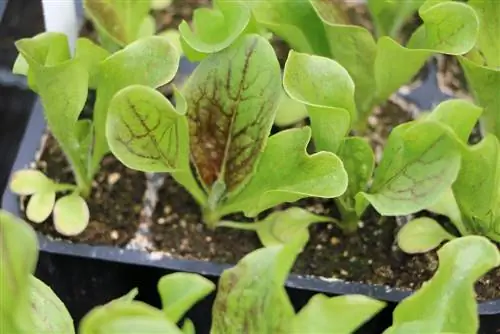
The variety predominantly grown in local gardens is the Rosso di Chioggia, which is mainly offered as seed by Dutch breeders and has been adapted to the climate in Northern and Central Europe through breeding.
Location
Due to its homeland, the radicchio prefers a warm and sunny location. Direct midday sun should therefore be avoided, especially in the hot summer months. A light partial shade is sufficient for it even if no other location can be found. The lettuce can also be grown in mixed culture. He gets along well next to:
- Marigolds
- Spinach, fennel, peas, beans, borage, cabbage
- Tomatoes, cucumber
- Chives, onions, nasturtiums, dill
However, direct cultivation next to other daisy family plants such as parsley, celery or radishes should be avoided. Depending on the hobby gardener's own preferences, the lettuce can be grown in the garden bed or in a raised bed.
Tip:
Anyone who already has one or more raised beds in their garden will appreciate the advantages. Because there is no need to bend over when caring for and harvesting. These beds also represent an obstacle for some ground-level pests, such as snails.
Substrate & Soil
A humus-rich, deep, loose and, above all, wet soil is suitable for growing radicchio. However, waterlogging is not tolerated by the plant. When preparing the bed, it is therefore advisable to add compost, sand and peat and mix well. To ensure that the soil in the bed is deep, it should be loosened up with a garden hoe in the first step, worked again with a rake in the second step and finally straightened with a garden rake. This avoids thick lumps of soil that are not suitable for sowing. The bed preparation should be done several weeks before sowing so that the nutrients in the compost are decomposed by the microorganisms living in the soil and can be released back into the soil. To ensure that the soil remains loose, it must be raked regularly during cultivation.
Sowing
Radicchio lettuce is sensitive to cold when sown. Therefore, pre-sowing in a greenhouse is recommended if this is to be done in March. However, this should be heatable so that a constant temperature prevails. Otherwise, it is quite common to sow the seeds in the outdoor garden bed in June:
- use prepared garden bed
- Draw rows
- to do this, place small sticks at the ends of the beds opposite
- connect with a string
- this makes the rows straight
- Distance between rows at least 30 centimeters
- Insert seeds approximately every 25 to 30 centimeters in the row
- will be placed more densely, must be separated later
- not deeper than two to three centimeters
- Do not press the soil down and keep it moist
Tip:
So that the harvest lasts longer, a few seeds should be sown every week, so that later not all lettuce plants will ripen at the same time.
Sowing on the windowsill
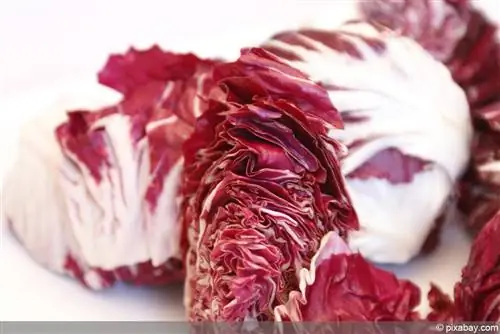
If you don't have a heated greenhouse available, which not every hobby gardener usually has in the garden, but would still like to sow the radicchio plants in advance in March/April, you can also place the plants on the windowsill or in one Pre-cultivate bright rooms. To do this, small pots are filled with a sand/soil mixture into which the individual seeds are placed about one to two centimeters deep. Then proceed as follows:
- Sprinkle soil lightly over it
- keep moist
- make sure there is constant heat in the room
- ideal is between 16° and 20° Celsius
- You can also put a transparent film over the pots
- but don’t forget to ventilate daily
- plant outdoors in June
Tip:
A heated indoor greenhouse can also be purchased for cultivation in a room. This doesn't take up much space, but the constant temperature can be regulated much better.
Plants
If radicchio was sown in March in a protected greenhouse or pre-cultivated on the windowsill, then it is planted outdoors in June. This only happens so late because the young plants in particular could react very sensitively to temperatures below 16° Celsius. When planting, the following should be taken into account:
- The planting distance is between 25 and 30 centimeters
- The distance between the individual rows should be at least 30 centimeters
- dig the planting holes accordingly
- since the plants have long roots, the holes should be deep enough
- Insert young lettuce and fill in soil
- press lightly
- water well
Tip:
When plants are grown in the greenhouse or in pots and later transferred to the garden bed, great care must be taken because the root forms a thick taproot that must not be damaged when planting.
Pouring
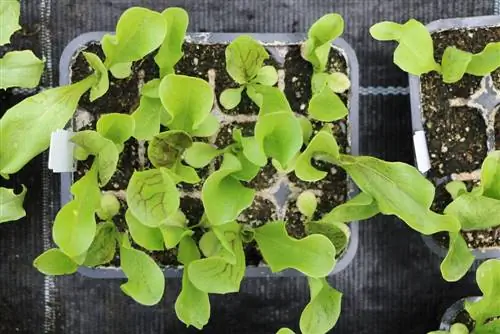
The soil for the radicchio salad should always be sufficiently wet. Therefore, it must be watered sufficiently in the summer months. Even if a little summer rain falls, it may not be able to adequately irrigate the soil. Therefore, it usually needs to be poured in here too. There are other things you should also pay attention to when watering:
- Preferably use collected rainwater
- Keep the soil wet, but avoid waterlogging
- regularly loosen the soil around the plants
- hill up the soil a little around the plants
- water only in the morning or evening
- always water only at the bottom of the roots
- Keep the leaves out of the water
- these could otherwise burn in the sun
Fertilize
Additional fertilizer application after bed preparation is not absolutely necessary. However, if the radicchio was grown in mixed culture in a bed, then adding a few fertilizers will not do any harm.
Tip:
If too much nitrogen is applied with the fertilizer, leaf edge burn can occur. If the heads start to rot, then you may have fertilized too much overall.
Wintering
There are winter-hardy varieties of radicchio. These are sown later; the seeds can be added to the bed until August. However, in order for the plants to survive the winter, they must be cut back to three centimeters above the ground in October. However, the cut leaves can be used in the kitchen. After the cut has been made, proceed as follows:
- all work must be done before the first frost
- After pruning, protect the bed with plant fleece or straw
- alternatively use tunnel with plastic cover
- place these above the individual rows
- remove the protection in late winter
- usually between February and March, depending on the climate
- can be harvested in March and April
Tip:
Even if cool nights are expected in summer, it is advisable to protect the cold-sensitive plants with a tunnel over the individual rows.
Propagate
If you like, you can also get the seeds from your own radicchio plants. In the second year, the lettuce plant produces light blue inflorescences up to two meters high, which are also extremely decorative. If the radicchio is not completely removed after harvest in the previous year and protected in winter, the new seeds can be harvested next year.
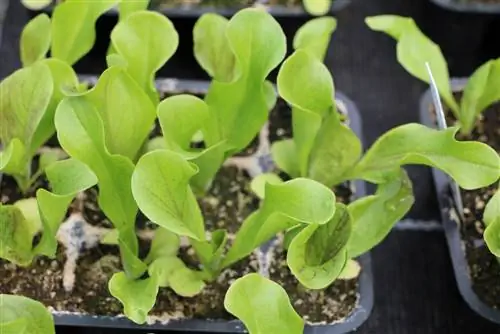
If the flowers have withered, the inflorescences are removed altogether and placed in a dry, warm place to dry or hung upside down. The seeds can then simply be removed and used as with sowing. The remaining lettuce plants in the bed can now also be completely removed and disposed of in the compost.
Harvest
Radicchio lettuce are very slow growing plants. The heads are ready to harvest after around eight weeks after sowing. However, in order for the red color to occur, the lettuce needs greater temperature fluctuations between day and night. It is therefore advisable to only harvest in the autumn between October and November if the red lettuce leaves are to be used in the kitchen. However, the color is irrelevant to the taste. Ideally, harvesting should be done as follows:
- cut the head above the ground with a sharp knife
- alternatively, individual leaves can also be removed
- so the rest of the head of lettuce stays fresh longer
- But even when harvested, radicchio can be stored for a long time
- cut it will last up to four weeks in the fridge
- with the roots removed it can be stored in a cool and dry place for a long time
Care errors, diseases or pests
Radicchio lettuce is generally not very susceptible to disease or pests. For example, aphids can attack lettuce heads. Insecticides from specialist retailers can help against this. However, if the lettuce plants have been treated with this, they must be washed and cleaned well before consumption. It is better to stretch a crop protection net over the bed as a preventive measure so that the pests cannot even get to the plants. Otherwise, the following diseases are known, mostly due to care errors:
- Leaf Edge Burn
- is caused by too much nitrogen in the fertilizer
- even if protective fleece is removed too late when rearing in spring
- the lettuce heads are rotting
- then too much fertilizer was administered
Tip:
Illnesses caused by care errors can easily be avoided if the care measures are followed correctly. Only aphids may need to be de alt with under certain circumstances.
Conclusion
Radicchio is an easy-care salad that can also be easily grown and harvested in local gardens. It is preferable to use the robust varieties, which are not particularly affected by a downpour or cooler summer weather. The care is not very complicated, you just have to make sure you water it enough. In return, the hobby gardener has a rich harvest of tasty radicchio from autumn to winter, on the first frosty days, which can be used in salads or as a vegetable.

